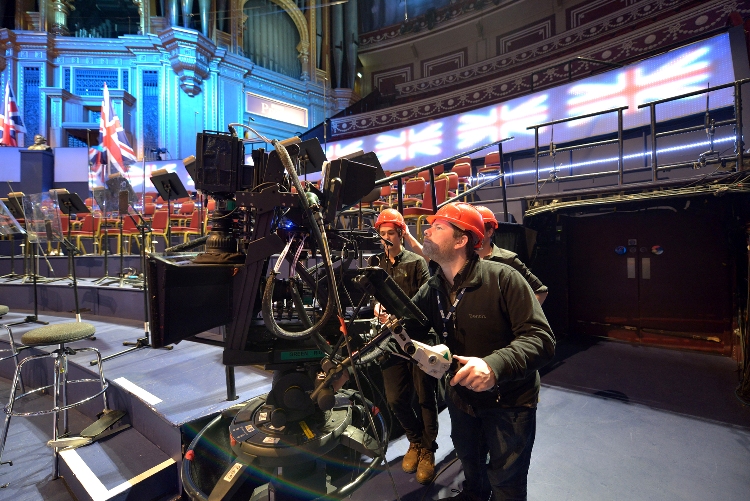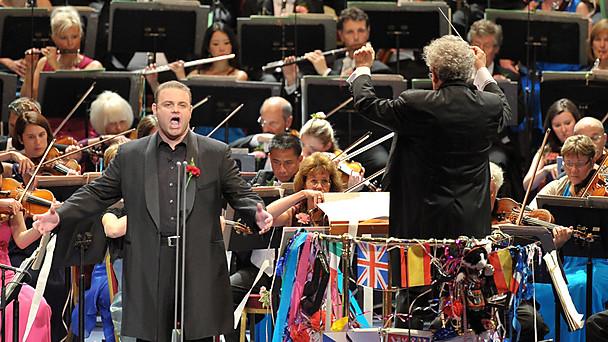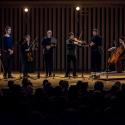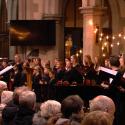During an orchestral rehearsal, it’s tense in a TV scanner at the best of times. A scanner is one of the huge vans parked outside the Royal Albert Hall with a wall of screens showing the shots from the cameras within. There’s a large huddle of BBC radio and television vans for the whole season. But there was another outside broadcast encampment on Saturday for the Last Night of the Proms, which was being broadcast in 3D for the first time. This is where all of us in the truck – members of the production team, technical experts, BBC executives - were wearing dark glasses to see the 3D image and looking surreally like a heavy security team.
“Can you edge in tighter to lose the microphone?” asks Jonathan Haswell directing the 3D coverage on talkback to the cameraman in the hall. We’re at the morning rehearsal with the BBC Symphony Orchestra running through the repertoire for the live broadcast at 7.30pm. Microphones never look very nice in the TV coverage, but in 3D they leap out in a much more intrusive way.
There are supposedly half a million 3D-enabled televisions in Britain
In the rehearsal the TV director, who has pre-scripted every shot in the show onto the music score, gets the only chance to check what will work and what won’t and make adjustments. I’m familiar with the process. I have also been doing it for nearly 20 years and had directed the live coverage of the Vienna Philharmonic the night before. But I wasn’t envying Haswell’s job.
Nicola Benedetti (pictured below) playing the violin looks sensational on the 3D camera – with a huge sense of space between her and the orchestra behind. You feel you could reach out and touch her. It changes the whole style of direction. In 2D you need to cut much more to get the perspective and cover the music, but in 3D it’s better to hold the shots and let your eyes explore them.
 Suddenly another camera lurches into shot from the left and then rises up completely masking Benedetti. “Bridget,” says Jonathan, “can you avoid coming too far right?” He’s speaking on talkback to Bridget Caldwell directing the 2D coverage in the other scanner.
Suddenly another camera lurches into shot from the left and then rises up completely masking Benedetti. “Bridget,” says Jonathan, “can you avoid coming too far right?” He’s speaking on talkback to Bridget Caldwell directing the 2D coverage in the other scanner.
“I don’t have the angle on her,” replies Caldwell.
“I don’t have a shot at all if you do that!” Haswell responds. The atmosphere is polite, but tense. The problem is virtually unreconcilable.
What makes this a logistical nightmare is covering the concert in 2D and 3D at the same time. You couldn’t just put the 2D coverage out in 3D – it would be sensory overload. And you couldn’t put the 3D coverage out in 2D as it would look slow and uninteresting. Hence two directors needing the same restricted places. But it’s also a public concert with a capacity audience of around 6,000.
There are 15 cameras in the hall: three are dedicated 3D cameras, six shared cameras, and six 2D cameras some of which are available to 3D with a bit of electronic fairy dust. No surprise they are clunking into each other and getting into each others’ shots.
3D cameras are essentially two cameras locked together to duplicate our two eyes. But because of the size of the cameras one is mounted horizontally, as you’d expect, and the other is mounted vertically pointing upwards with the image reflected 90 degrees in a mirror. The depth of the 3D image, or "covergence", is controlled by the distance between the two camera lenses which can be moved closer together and further apart. The wider they go, the more 3D it gets – until it becomes absurdly exaggerated. Before adjustment, a violinist coming into frame on the conductor shot seemed closer to my face than to the conductor. It means 3D cameras are twice the size of regular ones and each needs three operators in the outside broadcast chain.

After the rehearsal, Haswell seems troubled, but stoical. “Those last two numbers weren’t so dispiriting. When you get a clean shot in 3D it is glorious, but now it’s problem-solving rather than refining and improving. It’s a fight with uncertainly even though I’m surrounded by the best team in broadcasting.”
The coverage came into its own in the second half with the waving flags in wonderfully receding layers
The 3D broadcast is part of a two-year trial to evaluate the production, distribution and audience interest in 3D television. The Olympics 100m final and parts of the Opening and Closing Ceremony were broadcast on the BBC’s HD channel in 3D, so was the Strictly Come Dancing final. “We’re really pushing the boat out and we don’t know how smoothly it will go”, says Kim Shillinglaw, Commissioner for Science and Natural History and the BBC’s Head of 3D. “Some things will go well and some things will be horrible and we’ll take stock of that from a production point of view and an audience point of view. But I can still remember the first time I saw an orchestra playing and being in such proximity with the music made a much more vivid impression. If it goes well, the 3D experience is a step closer to feeling you are there.”
 There are supposedly half a million 3D-enabled televisions in Britain. Every new HD TV is 3D enabled (and comes with glasses). The 3D broadcast of Strictly last December peaked at 79,000 on the HD channel. It was also shown in selected cinemas, as was The Last Night on Saturday in 32 Odeon and Cineworld cinemas. We heard from someone at Cineworld Shaftsbury Avenue that there was a sizeable audience, “some with flags”. At the time of writing the cinema ticket sales have not been announced.
There are supposedly half a million 3D-enabled televisions in Britain. Every new HD TV is 3D enabled (and comes with glasses). The 3D broadcast of Strictly last December peaked at 79,000 on the HD channel. It was also shown in selected cinemas, as was The Last Night on Saturday in 32 Odeon and Cineworld cinemas. We heard from someone at Cineworld Shaftsbury Avenue that there was a sizeable audience, “some with flags”. At the time of writing the cinema ticket sales have not been announced.
The first breathtaking shot in the 3D transmission came straight off the opening titles as a crane in the Albert Hall gallery swung through the arches to reveal the whole hall below. Viewers with vertigo beware. In the wide shots you really did see the depth of the orchestra on stage – looking along a line of double basses the bows were coming out of the screen, and the whole size and depth of the hall was visible in new way.
Of course there were cameras that lurched into shot, but relatively few. The main drawback for 3D was the main camera in the Arena – getting the central soloist shots of Benedetti and tenor Joseph Calleja (pictured above) – was 2D sexed up for 3D, so looked flat in comparison to the others. It was felt it would be too obstructive to put a big 3D camera in the centre.
But the coverage came into its own in the second half with the waving flags in wonderfully receding layers – very international these days I’m pleased to say – the audience participation and Olympic medal-winners popping in for "Rule, Britannia!" It did feel closer to being there and it was a hugely successful experiment, I’d say, and I’m sure it’s a vision of the future. But, as with all these innovations, you end up talking more about the medium than the music.
- Watch The Last Night of the Proms on BBC iPlayer: part one and part two
- Read theartsdesk's 2012 Proms coverage
- See portraits of Proms performers by photographer Chris Christodoulou on theartsdesk's Facebook page














Add comment